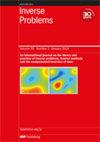声电断层扫描的可行性
IF 2
2区 数学
Q1 MATHEMATICS, APPLIED
引用次数: 0
摘要
声电层析成像(AET)的目标是通过对相应电流和电压的静电边界测量重建域中的电导率,同时域受到随时间变化的声波扰动,从而利用声电效应。我们分两步进行 AET 重建:首先,通过求解一个线性反问题和求解困难的问题,从边界测量中获得内部功率密度;其次,通过求解一个非线性和求解困难的问题,从功率密度中重建内部传导性。从数学角度来看,这些逆问题都相当容易理解,而且重建方法在合成数据上也很有效。这与实验结果截然不同。确实可以观察到效果,也可以收集数据。然而,声电耦合非常微弱,因此,与背景噪声相比,声学扰动引起的测量电压变化可能太小,无法进行可行的重建。在本文中,我们朝着了解 AET 的可行性迈出了一步。我们基于单个现象的标准模型,提供了一个耦合物理场景的内部模型。此外,我们通过两个步骤为逆问题制定并数值化了一个完整的重建方法。我们使用医学成像中实际选择的参数进行了计算实验。重点是了解声电耦合参数和信噪比(SNR)的作用。我们分析了临界信号强度,并估算了无处不在的约翰逊-奈奎斯特噪声。我们得出了正反两方面的结论:即使在严重的噪声条件下,我们也能重建特征,但我们也发现,在实践中可能面临的信噪比太低,无法获得有用的重建。本文章由计算机程序翻译,如有差异,请以英文原文为准。
Feasibility of acousto-electric tomography
In acousto-electric tomography (AET) the goal is to reconstruct the electric conductivity in a domain from electrostatic boundary measurements of corresponding currents and voltages, while the domain is perturbed by a time-dependent acoustic wave, thus taking advantage of the acousto-electric effect. We approach the AET reconstruction in two steps: First, the interior power density is obtained from boundary measurements by solving a linear inverse and ill-posed problem; second, the interior conductivity is reconstructed from the power density by solving a non-linear and well-posed problem. Mathematically these inverse problems are fairly well understood, and reconstruction methods work well on synthetic data. This is in contrast to experimental findings. An effect can indeed be observed and data can be collected. However, the acousto-electric coupling is very weak, and consequently, the change in the measured voltage due to the acoustic perturbation might be too small compared to the background noise for viable reconstructions. In this paper, we take one step towards understanding the feasibility of AET. We provide an in-silico model of the coupled physics scenario based on standard models for the individual phenomena. Moreover, we formulate and implement numerically a full reconstruction method for the inverse problem via the two steps. We perform computational experiments with realistically chosen parameters from the context of medical imaging. The focus is on understanding the role of the acousto-electric coupling parameter and the signal-to-noise ratio (SNR). The critical signal strength is analyzed and the omnipresent Johnson–Nyquist noise is estimated. We obtain both positive and negative findings; we can reconstruct features even under severe noise conditions, but we also find that the SNR one is likely to face in practice is too low to obtain useful reconstructions.
求助全文
通过发布文献求助,成功后即可免费获取论文全文。
去求助
来源期刊

Inverse Problems
数学-物理:数学物理
CiteScore
4.40
自引率
14.30%
发文量
115
审稿时长
2.3 months
期刊介绍:
An interdisciplinary journal combining mathematical and experimental papers on inverse problems with theoretical, numerical and practical approaches to their solution.
As well as applied mathematicians, physical scientists and engineers, the readership includes those working in geophysics, radar, optics, biology, acoustics, communication theory, signal processing and imaging, among others.
The emphasis is on publishing original contributions to methods of solving mathematical, physical and applied problems. To be publishable in this journal, papers must meet the highest standards of scientific quality, contain significant and original new science and should present substantial advancement in the field. Due to the broad scope of the journal, we require that authors provide sufficient introductory material to appeal to the wide readership and that articles which are not explicitly applied include a discussion of possible applications.
 求助内容:
求助内容: 应助结果提醒方式:
应助结果提醒方式:


